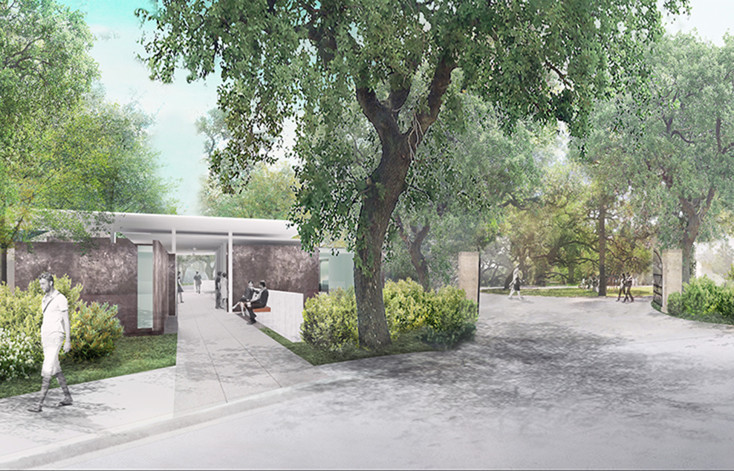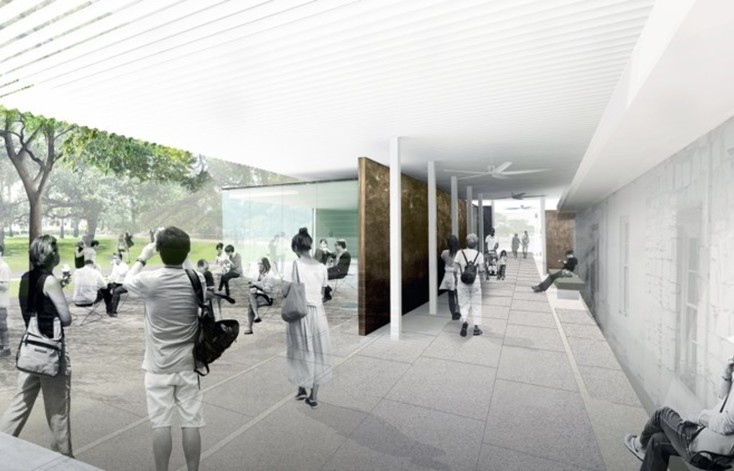Laguna Gloria Breaks Ground
First phase of construction begins today for The Contemporary Austin’s Betty and Edward Marcus Sculpture Park
Arrival Garden and Pavilions to greet visitors to The Contemporary Austin’s unparalleled art-in-nature experience on Lake Austin.
Removal of invasive plants sets the stage for healthier and more diverse ecological systems and enhanced curatorial opportunities.
The Contemporary Austin and Reed Hilderbrand Landscape Architecture announce the start of construction on Phase I of the Master Plan for the Betty and Edward Marcus Sculpture Park at Laguna Gloria. This 14-acre peninsula on Lake Austin, the historic home of Texan philanthropist Clara Driscoll, today features 20 site-specific works by internationally acclaimed contemporary artists, as well as the Art School at Laguna Gloria. Reed Hilderbrand, project lead, along with Trahan Architects, and ecologists from the Lady Bird Johnson Wildflower Center completed the Laguna Gloria master plan in 2015.
These improvements mark the beginning of a multi-year undertaking to implement the master plan. The first phase of construction is made possible by a $3 million grant from The Moody Foundation, building on previous grants from the Meadows Foundation, the Stillwater Foundation, and the Marcus Foundation, which offered the lead gift. The Contemporary Austin’s Board of Trustees has also generously advanced the project through gifts over the past years.
Groundbreaking on Phase I will take place on March 21, with construction expected to be complete in approximately one year. The groundbreaking ceremony will begin at 10 AM, is open to the public, and will include remarks by museum leadership and City of Austin officials.
Arrival Garden and Moody Pavilions
With its Moody Pavilions, the Arrival Garden establishes a new public face for the institution and clarifies a dedicated pedestrian entry from West 35th Street just south of the historic gate. A tall, colorful sculpture by artist Jessica Stockholder, placed at the terminus of West 35th Street, announces arrival at Laguna Gloria.
Here, architecture and landscape are conceived as an integrated and unified experience. A series of vertical steel planes and steel and glass pavilions draw visitors into the park through a sequence of shady outdoor spaces. The composition of structures, walls, and gardens are organized along a central walk covered by a high trellis. Concrete site walls, stonedust paving, and lush plantings further enclose two outdoor courts for patrons to gather and linger while taking in views of the property’s mature live oak canopy, 100-year old Italianate villa, and compelling works of art.
The design of the area provides a range of visitor services at the property entrance, which introduces guests to the unique offerings of the sculpture park. The Pavilions house a welcome center, an outdoor cafe, and a museum retail shop — amenities that never existed on site before. A modern material palette of weathered steel, plate glass, and concrete is carefully detailed and scaled to defer to the site’s landscape and existing historic structures. The villa gatehouse, modified several times over the years to accommodate administrative needs, is repurposed to provide restrooms and increased storage.
“Phase I of the Laguna Gloria Master Plan will have an enormous impact on what a visit to Laguna Gloria will feel like,” said Louis Grachos, the Ernest and Sarah Butler Executive Director and CEO of The Contemporary Austin. “We’re literally opening up walls along the new entryway, so there will be no mistake that all of Austin is welcome to enjoy the unique encounters with art and nature that can only be found at Laguna Gloria.”
“This has been a unique commission for us and our team of collaborators,” said Douglas Reed, FASLA, founding principal and partner of Reed Hilderbrand. “There is no place quite like Laguna Gloria. I want to honor the vision and commitment of The Contemporary’s Board, most significantly the bold and generous lead gift of the Marcus Foundation.”
Reed Hilderbrand’s design leadership for The Contemporary Austin, from the 2013 competition until today, has been the responsibility of principal and partner John Christopher Moyles, ASLA, who unexpectedly passed away earlier this month. The firm’s commitment to excellence in all of its work at Laguna Gloria will be a tribute to and celebration of Chris’s passion for building and conviction in the transformative power of landscape architecture.
Protecting Native Texas Plants
The master plan propelled an ambitious program to remove all invasive plants from the property. Conceived by Reed Hilderbrand with guidance by LBJ Wildflower Center, the removal efforts target a few simple goals: to open views of outdoor sculpture and beyond to Lake Austin, encourage native species to thrive, and to preserve over 150 heritage trees. The first phase of the project focuses on the removal of woody invasive plants within the woodland areas. Species such as Chinaberry, Chinese Tallow, Japanese Knotweed, and bamboo have prevailed for many years, out-competing native Texas plants. Future phases include the removal of invasive herbaceous plants and the amendment of the soil in open meadow areas. The stabilization of Laguna Gloria’s shoreline, soon to follow in construction, will preserve and protect the wetland edge along Lake Austin.
The Project Team
Reed Hilderbrand’s collaboration with The Contemporary Austin began in Summer 2014, following an international design competition to identify a lead designer. The concept vision and site master plan for the Betty and Edward Marcus Sculpture Park was completed in 2015 in collaboration with Trahan Architects and LBJ Wildflower Center. Planned future investments in the property have successfully guided new programming, maintenance, and operations protocols, transforming the way artists and visitors alike engage with the environment. Phase I’s construction will inaugurate a new identity for the site focused on enhanced visitor experience to complement ongoing curatorial efforts to install new works. Future phases of the project will address the core of the sculpture park, improving circulation and spatial clarity through a diversity of landscape spaces intended to inspire artists and enrich visitor experiences.
In addition to Reed Hilderbrand, Trahan Architects, and LBJ Wildflower Center, the team also includes local Austin firms Urban Design Group (engineering), Beck Group (general contractor), Benz Resource Group (project management) and Nelsen Partners (consultation).

